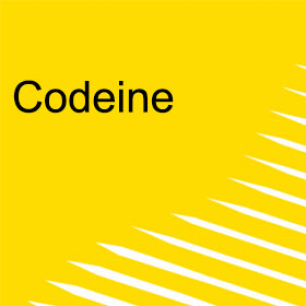Codeine
What is codeine?
Codeine is an ingredient contained in a number of pain medicines - it is an analgesic (painkiller). It is in the same family of medicines as opioid pain medications and drugs such as morphine, oxycodone and heroin.
As of 1 February 2018, medicines containing codeine are no longer sold over the counter in Australian pharmacies and are available by prescription only. This decision was made by the Therapeutic Goods Administration (TGA) following substantial evidence of harm from the abuse and misuse of low dose codeine-containing medicines including analgesic preparations combined with other pain relief medicines such as aspirin, paracetamol and ibuprofen (AIHW, 2020).
What are the effects?
Codeine is used to treat pain and has cough suppressant effects. It may be known by common brand names including Nurofen Plus, Panadeine Forte and Codral Cold and Flu. When prescribed it is taken orally as a tablet or a cough syrup.
Codeine is converted into morphine by the body, which is thought to be responsible for almost all of its pain-relieving effects. At recommended doses, and for short-term use, these medications are relatively safe. Effects include:
- Pain relief
- Drowsiness
- Cough suppression
- Constipation
What are the risks?
When combination codeine products are used at high doses, particularly over long periods of time, harms such as ulcers, severe bleeds in the stomach and organ damage have been reported. These harms are usually from taking high doses of the ingredients such as ibuprofen or paracetamol that are combined with codeine.
Codeine, like morphine and other opioids, can cause opioid tolerance, dependence, toxicity and in higher doses, death (TGA, 2018).
Some people use codeine to get high, by intentionally taking more than the recommended dose; or as an act of self-harm (ADF, 2019).
Mixing codeine with other drugs
The effect of taking codeine with other drugs, including alcohol, prescription medications and other over-the-counter medicines, is often unpredictable. Codeine taken with alcohol can cause mental clouding, reduced coordination and slow breathing (ADF, 2019).
Toxicity and overdose
Codeine shares the properties of other opioid analgesics and is capable of producing dependence, respiratory depression, reduced levels of consciousness, and in overdose, respiratory failure and death. The risks associated with codeine use in children under the age of 12 are of great concern (TGA, 2018).
Dependence and withdrawal
Severe withdrawal symptoms can result when medicine containing codeine is stopped abruptly when dependence has formed. Some of these withdrawal symptoms, such as headaches or muscle aches, mimic the symptoms that low-dose codeine products are often used to treat, leading to people incorrectly continuing to take the medicine longer or in higher doses (TGA, 2018).
Signs of codeine dependence:
- Loss of appetite and weight loss
- Nausea and vomiting
- Cold sweats, clammy hands and feet
- Poor physical coordination
- Using more codeine to get the same effect and unable to stop or cut down the use of codeine
- Confusion
- Mood swings
- Changes in sleeping patterns (TGA, 2018)
Treatment
The most common treatment for opioid dependence is opioid agonist treatment. Opioid agonist treatment is also called medication-assisted treatment of opioid dependence (MATOD). The most common medicines used for treatment in Australia are methadone, buprenorphine and buprenorphine-naloxone.
Other options include residential rehabilitation, a drug-free treatment, requiring residence in a treatment agency after having undertaken detoxification. Programs may be short (approximately one month) or longer (at least three to six months). Counselling and withdrawal-management are also available.
Emergency info
If you, or someone around you, is experiencing undesired or distressing psychological or physical symptoms from the intake of alcohol or other drugs please seek immediate medical attention.
If you need urgent help from ambulance services call Triple Zero (000). If a person has been mixing drugs with alcohol or other drugs, tell the paramedic exactly what has been taken.
Services
For free and confidential advice about alcohol and other drugs, call the National Alcohol and Other Drug hotline on 1800 250 015.
The hotline will automatically direct you to the Alcohol and Drug Information Service in your state or territory.
More resources
The Illicit Drug Reporting System is an Australian monitoring system that identifies emerging trends of local and national interest in illicit drug markets.
The Ecstasy and Related Drugs Reporting System is an Australian monitoring system for ecstasy and related drugs that identifies emerging trends of local and national interest.
The Clinician’s Guide to Illicit Drugs and Health examines the health effects of each of the major illicit drugs.
The Australian Institute of Health and Welfare collects information on alcohol and tobacco consumption, and illicit drug use among the general population in Australia.
The Australian Bureau of Statistics is Australia’s national statistical agency, providing official statistics on a range of economic, social, population and environmental matters of importance to Australia.
Sources
Alcohol and Drug Foundation (2019). Codeine. Retrieved from https://adf.org.au/drug-facts/codeine/
Australian Government Department of Health Therapeutic Goods Administration (2018). Changes to patient access for medicines containing codeine. Retrieved from: https://www.tga.gov.au/codeine-info-hub
Australian Institute of Health and Welfare (2019). Alcohol, tobacco & other drugs in
Australia. Cat. no. PHE 221. Canberra: AIHW. Retrieved from
https://www.aihw.gov.au/reports/alcohol/alcohol-tobacco-other-drugs-australia


